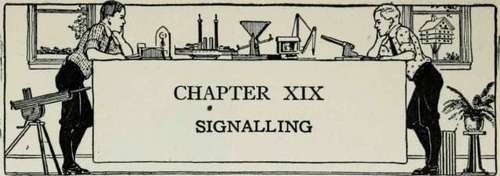Chapter XIX. Signalling
Description
This section is from the book "Carpentry And Mechanics For Boys", by A. Neely Hall. Also available from Amazon: Carpentry and Mechanics for Boys.
Chapter XIX. Signalling

Every boy ought to know how to converse by means of one of the several signal systems in common use. About the simplest system to learn, and one which makes rapid sending possible, is the two-arm semaphore system; therefore, the way to make a pair of hand signal flags, and the signal-code, is shown in this chapter.

Two-Arm Semaphore Signaling by a Patrol of the Author's Troop of Boy Scouts of America, Elmhurst, Ills.
It is not necessary to own a pair of flags to learn the code, since the positions of the arms of the boy signalling determine the code letters. The flags serve to amplify the hand positions, and of course this is necessary when sending from a distance. It is easiest to learn the code without the flags, because then you need concern yourself only with the positions of your arms in forming the letters. As soon as you have memorized the positions, and can send at a rate of at least thirty letters a minute, you will be so proud of your achievement that you will want to own a pair of flags at once.
A Hand Flag of Standard Size is shown in Fig. 468, its dimensions are given in Fig. 469, and the size of its staff is shown in Fig. 470. The flag is divided diagonally into two parts, one of which is made of red muslin, the other of white. Cut the cloth enough larger than shown to allow for turning over 1/4 inch of each edge for a hem. If you have mother or sister do this stitching on the sewing-machine, it will be the best way of getting a good job done quickly. Cut the staff stick of the size shown, round the edges, and sandpaper all surfaces smooth. Then shellac it, and when the shellac has dried tack the flag to one side.
Memorizing the Code is not difficult, but it requires continuous practice to get to the point where one can send rapidly. The following suggestions will help you "get the hang" of it, and probably you will be able to work out schemes of your own that will help you remember the formation of certain letters.
Observe, first of all,

Fig. 468. - Hand Flag

Fig. 469. - Pattern for Hand Flag

Fig. 470. - Staff for Hand Flag that the positions of the arms in forming the letters of the alphabet are eight in number, and correspond to the positions of the hour-hand of a clock when at 6 o'clock, 7:30, 9 o'clock, 10:30, 12 o'clock, 1:30, 3 o'clock, and 4:30. Observe, also, that the arms advance clockwise, in going through the alphabet.
In forming letters A to D, the left hand is placed in the position of a clock's hour-hand when at 6 o'clock, the right-hand is placed successively at 7:30, 9 o'clock, 10:30, and 12 o'clock. In forming letters E to G, the right hand is substituted for the left hand, and the left hand is advanced from 1:30 to 4:30. For letters H and I, the left hand is held at 7:30, the right hand is placed at 9 o'clock, then at 10:30. Letters K to N are formed with the right-hand held at 7:30, the left hand is placed successively at 12 o'clock, 1:30, 3 o'clock, and 4:30. For letters P to S, the right hand is held at 9 o'clock, the left hand is placed successively at 12 o'clock, 1:30, 3 o'clock, and 4:30.
For letters T, U, and Y, the right-hand is held at 10:30, the left hand is placed at 12 o'clock, 1:30, and 3 o'clock. For letters / and V, the right hand is held at 12 o'clock, the left hand is placed at 3 o'clock and 4:30. For letters W and X, the left hand is held at 1:30, the right hand at 3 o'clock and 4:30. For letter Z, the left hand is held at 3 o'clock, the right hand at 4:30.
Remember that the letter U is like a letter U., that letter N is U inverted (same as small letter n is letter u inverted); letter Y is like a letter Y except that the left-hand is dropped one position; letter X is really the left-hand side of a letter X. Opposite letters are A and G, B and F, C and E, H and Z, I and X, J and P, K and V, O and W (think of O and "double-yo"), M and 5, and Q and F. Perhaps you will find it helpful to associate these letters in this way.

Fig. 471. - Signal Code
To Attract Attention, before starting to signal, shake the flags above your head in the positions indicated for attention. Before sending numerals, cross the flags over head as shown for numerals. Use letters A to J for numbers. Spell out numerals when they come in the body of a message. If you make an error, signal A. To annul a message, make A7. To acknowledge that the message has been understood, make R. To signify readiness, send L. Indicate a negative reply by K, an affirmative reply by P, a question by 0.
Finish a Message with a chop-chop motion of the flags at the right, as indicated for "end." Abbreviations will not be confused with letters, by the receiver, if the sender follows them with the interval.
Continue to:


